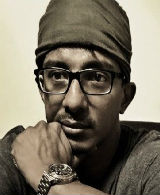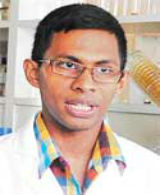Suranga Nanayakkara
 Suranga Nanayakkara was born in 1981. Having received his secondary education from Royal College, Colombo, he completed bachelor's degree in electrical and computer engineering from the National University of Singapore in Singapore. He holds a PhD in Engineering from National University of Singapore. Suranga spent half a year at University of Birmingham and half a year at University of Southern California under student exchange program. Later he was a postdoctoral researcher with Pattie Maes’s Fluid Interfaces Group at MIT Media Lab.
Suranga Nanayakkara was born in 1981. Having received his secondary education from Royal College, Colombo, he completed bachelor's degree in electrical and computer engineering from the National University of Singapore in Singapore. He holds a PhD in Engineering from National University of Singapore. Suranga spent half a year at University of Birmingham and half a year at University of Southern California under student exchange program. Later he was a postdoctoral researcher with Pattie Maes’s Fluid Interfaces Group at MIT Media Lab.
As of 2014, he was the head of Augemented Human Lab and Assistant Professor at Singapore University of Technology and Design. He is best known for his work on EyeRing and Haptic Chair. His research interests include Wearable Computing, Assistive Technology, Ubiquitous computing, AI, Collective intelligence and Robotics. MIT Technology Review honored Nanayakkara as one of the Innovators Under 35 for Asia Pacific Region 2014.
Suranga is best known for his work EyeRing - A finger-worn interface for seamless interactions Haptic Chair - Audio visual system to provide a more satisfying musical experience to deaf people and StickEars – a sound-based sticky note like device to make everyday objects more accessible. Among some of his other work, Suranga has invented SPARSH – a way to copy-paste data between digital devices; FingerDraw - way to extract colours and textures from nature and bring them into digital drawings.
Ranga Dias
 Ranga Dias is currently a research fellow in the Department of Physics at Harvard University. His research focuses on probing quantum phenomena under extreme pressures and temperatures. In particular, high Tc superconductivity, magnetism and superfluity in the vicinity of quantum phase transitions. His main contributions include discovery of solid metallic hydrogen, the holy grail of extreme condensed matter physics - a feat that physicists have been trying to accomplish for more than 80 years, discovery of new class of highly conducting metallic and superconducting polymers synthesis of optically nonlinear, superhard and high density solid CO2-V, first observation of Dissociation–Recombination process (DISREC) in Dense hydrogen deuteride, discovery of new quantum phase transition in dense hydrogen. His work has also been reported in popular press, e.g. New York Times, BBC, NBC, NPR, Physics Today, New Scientist, Chemistry World, ScienceNews, Nature news and views, APS physics central.
Ranga Dias is currently a research fellow in the Department of Physics at Harvard University. His research focuses on probing quantum phenomena under extreme pressures and temperatures. In particular, high Tc superconductivity, magnetism and superfluity in the vicinity of quantum phase transitions. His main contributions include discovery of solid metallic hydrogen, the holy grail of extreme condensed matter physics - a feat that physicists have been trying to accomplish for more than 80 years, discovery of new class of highly conducting metallic and superconducting polymers synthesis of optically nonlinear, superhard and high density solid CO2-V, first observation of Dissociation–Recombination process (DISREC) in Dense hydrogen deuteride, discovery of new quantum phase transition in dense hydrogen. His work has also been reported in popular press, e.g. New York Times, BBC, NBC, NPR, Physics Today, New Scientist, Chemistry World, ScienceNews, Nature news and views, APS physics central.
Manju Gunawardana
 Manju Gunawardana hails from Matara. He was a student of Mahanama College and Royal College Colombo. He received his primary engineering education from the Engineering Council of UK and post graduate qualification from the University of Houston Texas on a special scheme of research with Raytheon Aerospace.
Manju Gunawardana hails from Matara. He was a student of Mahanama College and Royal College Colombo. He received his primary engineering education from the Engineering Council of UK and post graduate qualification from the University of Houston Texas on a special scheme of research with Raytheon Aerospace.
He has 25 years experience in innovation, technology integration and research. He won 2 gold medals in 42nd international innovation congress in Geneva and 1 gold medal and 1 silver medal in 41st international innovation congress in Geneva. He is the Young inventor of the year and gold medal winner in 1990.
He is a Consultant-nanotech applications of Sri Lanka Institute of Nanotechnology SLINTEC) and Research Scientist/ CEO at Hybrid Technologies Pvt Ltd.
Rakitha Malewana
 Rakitha Malewana is a Sri Lankan inventor, scientist, scientific researcher and youth activist. He works primarily in Medical and Molecular Biology research. Rakitha is known for his award-winning work on developing successful therapies for HIV/AIDS and Leukemia, which he performed while he was a high school student. He received special appreciation grand achievement award from the President and the government of Democratic Socialist Republic of Sri Lanka. In 2016, he was announced as a winner of prestigious Queen's Young Leaders Award by the Royal Commonwealth Society as an honor to his social work on behalf of the HIV and AIDS positive community.
Rakitha Malewana is a Sri Lankan inventor, scientist, scientific researcher and youth activist. He works primarily in Medical and Molecular Biology research. Rakitha is known for his award-winning work on developing successful therapies for HIV/AIDS and Leukemia, which he performed while he was a high school student. He received special appreciation grand achievement award from the President and the government of Democratic Socialist Republic of Sri Lanka. In 2016, he was announced as a winner of prestigious Queen's Young Leaders Award by the Royal Commonwealth Society as an honor to his social work on behalf of the HIV and AIDS positive community.
Rakitha does his medical research in collaboration with University of Colombo, Medical Research Institute Sri Lanka, National Science Foundation of Sri Lanka, Ministry of Health and Government Annalists Department Sri Lanka.
He won a Gold medal for the research he has done on HIV/AIDS at the International Scientific Research Olympiad 2015 held in Jakarta, Indonesia in year 2015. In the same year he won another Gold Medal at the International Environment Sustainability Olympiad 2015, held in The Netherlands By emerging those medals, he became the first Sri Lankan to win an Olympiad gold medal at the international arena.
His research using Nanotechnology as a functional therapeutic drug on human leukemic cells, won a Bronze Medal at the International Science Projects Olympiad 2014 held in Jakarta, Indonesia. In year 2012 Rakitha invented a novel way of irrigation water conservation (Simplified and Low Costing Field Capacity Testing Device) and it won a merit Award at Stockholm Junior Water Prize National Competition. Also Rakitha had authored few medical publications during his high school period.
Dinesh Katugampala
 Dinesh Katugampala studied at Bomiriya National School and D. S. Senanayake College. The most significant innovation of him is the world’s first radius metre - a device to find the radius of any sphere or arc. He invented the apparatus in 2008, when he was a final year student of the National Diploma in Technology (NDT) at the University of Moratuwa, following textile and clothing engineering technology. His mathematical derivation used in building this device is called the Square Dual Theorem and is the basis for the radius metre. In the year 2009 he patented both his creation and the mathematical formula. His invention has won him international accolades as well bringing honor to Sri Lanka. In 2012, it won him the silver medal in the field of industrial equipment at the World Innovation Exhibition in Geneva, organized by the World Intellectual Property Organization. He also wants his Square Dual Theorem to be included in mathematics textbooks and taught in schools.
Dinesh Katugampala studied at Bomiriya National School and D. S. Senanayake College. The most significant innovation of him is the world’s first radius metre - a device to find the radius of any sphere or arc. He invented the apparatus in 2008, when he was a final year student of the National Diploma in Technology (NDT) at the University of Moratuwa, following textile and clothing engineering technology. His mathematical derivation used in building this device is called the Square Dual Theorem and is the basis for the radius metre. In the year 2009 he patented both his creation and the mathematical formula. His invention has won him international accolades as well bringing honor to Sri Lanka. In 2012, it won him the silver medal in the field of industrial equipment at the World Innovation Exhibition in Geneva, organized by the World Intellectual Property Organization. He also wants his Square Dual Theorem to be included in mathematics textbooks and taught in schools.






